
“Eating with chopsticks”, c. 1910. Two young girls enjoying zaru soba [chilled noodles]. Chopsticks have been used as kitchen and eating utensils in most of East Asia for over 3,000 years. In Japanese, chopsticks are called hashi (phonetically identical to the word for “bridge” but with a completely different meaning: 箸 vs. 橋). Hashi are also known in Japan as otemoto, a phrase commonly printed on the wrapper of disposable chopsticks. Te means “hand” and moto means “the area under or around something”. (The preceding o is used as an honorific.)
See also:
Rice culture, c. 1910.
Public nutrition campaign, c. 1930.
Early history of school lunches in Japan.
“Salt fields at Mita”, c. 1940.
“Looking around for knife, fork, and spoon, you suddenly remember. In Japanese, I am told, the same word [hashi] means both bridge and chopsticks. It is as easy, at first, to eat with one as with the other, the odds possibly favoring the bridge.
“Taking a stick in each hand, drummer fashion, is strictly against the rules; they should be wielded simultaneously by the right hand. No, not that way, please, but like this, sir, one held firmly between the second and third fingers, the other loosely, like a pen, between thumb and the tips of fingers one and two. Thus they become elongated digits, serving as tongs, scissors, spade, spear, and ladle.
“It looks simple. You try, and fail. The guide may be wrong; he admits that his mother still scolds him because he does not chopstick like other people. You guessed it, and straight-way appeal to the maid, who is mightily pleased and proceeds to give a private lesson, all but putting a piece of seaweed into your mouth.
“But seaweed, even when thus administered, does not appeal to you strongly at that particular moment; so you draw back just in time.
“… Really chopsticks are not half bad, provided full advantage be taken of every accident. Boldness, strategy, accident – that is the whole secret, plus an occasional surreptitious use of the fingers.”
– Over Japan Way, by Alfred Marshall Hitchcock, 1917



Pingback: Soba culture, c. 1910. | Old TokyoOld Tokyo
Pingback: “Buckwheat noodle (soba) house” deliveryman, c. 1920. | Old TokyoOld Tokyo